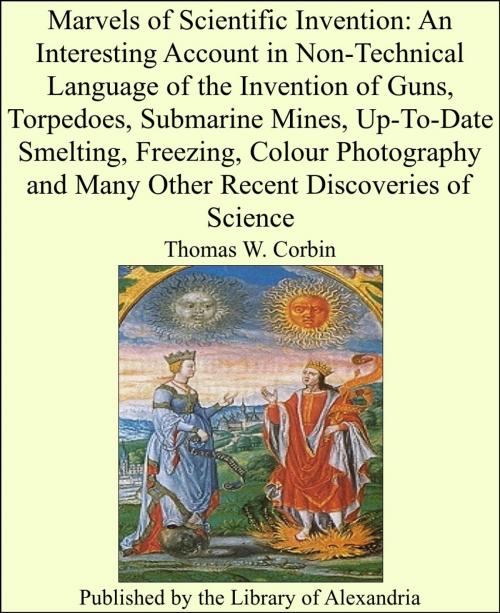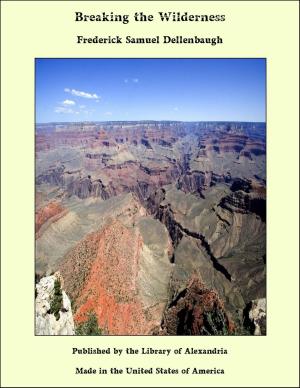Marvels of Scientific Invention: An Interesting Account in Non-Technical Language of the Invention of Guns, Torpedoes, Submarine Mines, Up-To-Date Smelting, Freezing, Colour Photography and Many Other Recent Discoveries of Science
Nonfiction, Religion & Spirituality, New Age, History, Fiction & Literature| Author: | Thomas W. Corbin | ISBN: | 9781465511973 |
| Publisher: | Library of Alexandria | Publication: | March 8, 2015 |
| Imprint: | Language: | English |
| Author: | Thomas W. Corbin |
| ISBN: | 9781465511973 |
| Publisher: | Library of Alexandria |
| Publication: | March 8, 2015 |
| Imprint: | |
| Language: | English |
Most people are afraid of the word explosion and shudder with apprehension at the mention of dynamite. The latter, particularly, conjures up visions of anarchists, bombs, and all manner of wickedness. Yet the time seems to be coming when every farmer will regard explosives, of the general type known to the public as dynamite, as among his most trusty implements. It is so already in some places. In the United States explosives have been used for years, owing to the exertions of the Du Pont Powder Company, while Messrs Curtiss' and Harvey, and Messrs Nobels, the great explosive manufacturers, are busy introducing them in Great Britain. It will perhaps be interesting first of all to see what this terror-striking compound is. One essential feature is the harmless gas which constitutes the bulk of our atmosphere, nitrogen. Ordinarily one of the most lazy, inactive, inert of substances, this gas will, under certain circumstances, enter into combination with others, and when it does so it becomes in some cases the very reverse of its usual peaceful, lethargic self. It is as if it entered reluctantly into these compounds and so introduced an element of instability into them. It is like a dissatisfied partner in a business, ready to break up the whole combination on very slight provocation. And it must be remembered that an explosive is simply some chemical compound which can change suddenly into something else of much larger volume. Water, when boiled, increases to about 1600 times its own volume of steam, and if it were possible to bring about the change suddenly water would be a fairly powerful explosive. Coal burnt in a fire changes, with oxygen from the atmosphere, into carbonic acid gas, and the volume of that latter which is so produced is much more than that of the combined volumes of the oxygen and coal. When the burning takes place in a grate or furnace we see nothing at all like an explosion, for the simple reason that the change takes place gradually. That is necessarily so since the coal and oxygen are only in contact at the surface of the former. If, however, we grind the coal to a very fine powder and mix it well with air, then each fine particle is in contact with oxygen and can burn instantly. Hence coal-dust in air is an explosive. It used to be thought that colliery accidents were due entirely to the explosion of methane, a gas which is given off by the coal, but it has of recent years dawned upon people that it is the coal-dust in the mine which really does the damage. The explosion of methane stirs up the dust, which then explodes. The former is comparatively harmless, but it acts as the trigger or detonator which lets loose the force pent up in the innocent-looking coal-dust. Hence the greatest efforts in modern collieries are bent towards ridding the workings of dust or else damping it or in some other way preventing it from being stirred up into the dangerous state. So the essential feature of any explosive is oxygen and something which will burn with it. If it be a solid or liquid the oxygen must be a part of the combination or mixture, for it cannot get air from the surrounding atmosphere quickly enough to explode; and, moreover, it is generally necessary that explosives should work in a confined space away from all contact with air. So oxygen, of necessity, must be an integral part of the stuff itself. But when oxygen combines with anything it usually clings rather tenaciously to its place in the compound and is not easily disturbed quickly, and that is where the nitrogen seems to find its part. It supplies the disturbing element in what would otherwise be a harmonious combination, so that the oxygen and the burnable substances readily split up and form a new combination, with the nitrogen left out
Most people are afraid of the word explosion and shudder with apprehension at the mention of dynamite. The latter, particularly, conjures up visions of anarchists, bombs, and all manner of wickedness. Yet the time seems to be coming when every farmer will regard explosives, of the general type known to the public as dynamite, as among his most trusty implements. It is so already in some places. In the United States explosives have been used for years, owing to the exertions of the Du Pont Powder Company, while Messrs Curtiss' and Harvey, and Messrs Nobels, the great explosive manufacturers, are busy introducing them in Great Britain. It will perhaps be interesting first of all to see what this terror-striking compound is. One essential feature is the harmless gas which constitutes the bulk of our atmosphere, nitrogen. Ordinarily one of the most lazy, inactive, inert of substances, this gas will, under certain circumstances, enter into combination with others, and when it does so it becomes in some cases the very reverse of its usual peaceful, lethargic self. It is as if it entered reluctantly into these compounds and so introduced an element of instability into them. It is like a dissatisfied partner in a business, ready to break up the whole combination on very slight provocation. And it must be remembered that an explosive is simply some chemical compound which can change suddenly into something else of much larger volume. Water, when boiled, increases to about 1600 times its own volume of steam, and if it were possible to bring about the change suddenly water would be a fairly powerful explosive. Coal burnt in a fire changes, with oxygen from the atmosphere, into carbonic acid gas, and the volume of that latter which is so produced is much more than that of the combined volumes of the oxygen and coal. When the burning takes place in a grate or furnace we see nothing at all like an explosion, for the simple reason that the change takes place gradually. That is necessarily so since the coal and oxygen are only in contact at the surface of the former. If, however, we grind the coal to a very fine powder and mix it well with air, then each fine particle is in contact with oxygen and can burn instantly. Hence coal-dust in air is an explosive. It used to be thought that colliery accidents were due entirely to the explosion of methane, a gas which is given off by the coal, but it has of recent years dawned upon people that it is the coal-dust in the mine which really does the damage. The explosion of methane stirs up the dust, which then explodes. The former is comparatively harmless, but it acts as the trigger or detonator which lets loose the force pent up in the innocent-looking coal-dust. Hence the greatest efforts in modern collieries are bent towards ridding the workings of dust or else damping it or in some other way preventing it from being stirred up into the dangerous state. So the essential feature of any explosive is oxygen and something which will burn with it. If it be a solid or liquid the oxygen must be a part of the combination or mixture, for it cannot get air from the surrounding atmosphere quickly enough to explode; and, moreover, it is generally necessary that explosives should work in a confined space away from all contact with air. So oxygen, of necessity, must be an integral part of the stuff itself. But when oxygen combines with anything it usually clings rather tenaciously to its place in the compound and is not easily disturbed quickly, and that is where the nitrogen seems to find its part. It supplies the disturbing element in what would otherwise be a harmonious combination, so that the oxygen and the burnable substances readily split up and form a new combination, with the nitrogen left out















